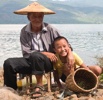 Jim Salinger of NIWA gave a talk on climate change and its implications for New Zealand’s wine growers at their annual Romeo Bragato conference, held in Auckland at the end of August.. The Herald reported some of the likely changes:
Jim Salinger of NIWA gave a talk on climate change and its implications for New Zealand’s wine growers at their annual Romeo Bragato conference, held in Auckland at the end of August.. The Herald reported some of the likely changes:
In the Gisborne area, chardonnay was likely to be replaced by shiraz, grenache and zindafel, while chardonnay and merlot were likely to be replaced by shiraz and malbec in Hawke’s Bay. Wairarapa’s pinot noir could be supplanted by merlot, malbec and cabernet franc grapes while cabernet sauvignon and merlot were likely to replace sauvignon blanc in Marlborough. In Canterbury, sauvignon blanc could replace chardonnay, while the pinot noir very suited to both Canterbury and Otago, could spread out to higher altitude sites in these regions.
Meanwhile, Napa Valley wineries are concerned about predictions that their premium vineyards could be worthless by the second half of this century, and in Alsace growers are reporting that climate change is already having a dramatic impact:
On a cobweb-encrusted rafter above his giant steel grape pressers, Rene Mure is charting one of the world’s most tangible barometers of global warming. The evidence, scrawled in black ink, is the first day of the annual grape harvest for the past three decades. In 1978, it was Oct. 16. In 1998, the date was Sept. 14. This year, harvesting started Aug. 24 — the earliest ever recorded, not only in Mure’s vineyards, but also in the entire Alsace wine district of northeastern France.
Mure wants to experiment with Rhone varietals like syrah, but France’s appellation rules make that difficult.
Like this:
Like Loading...




